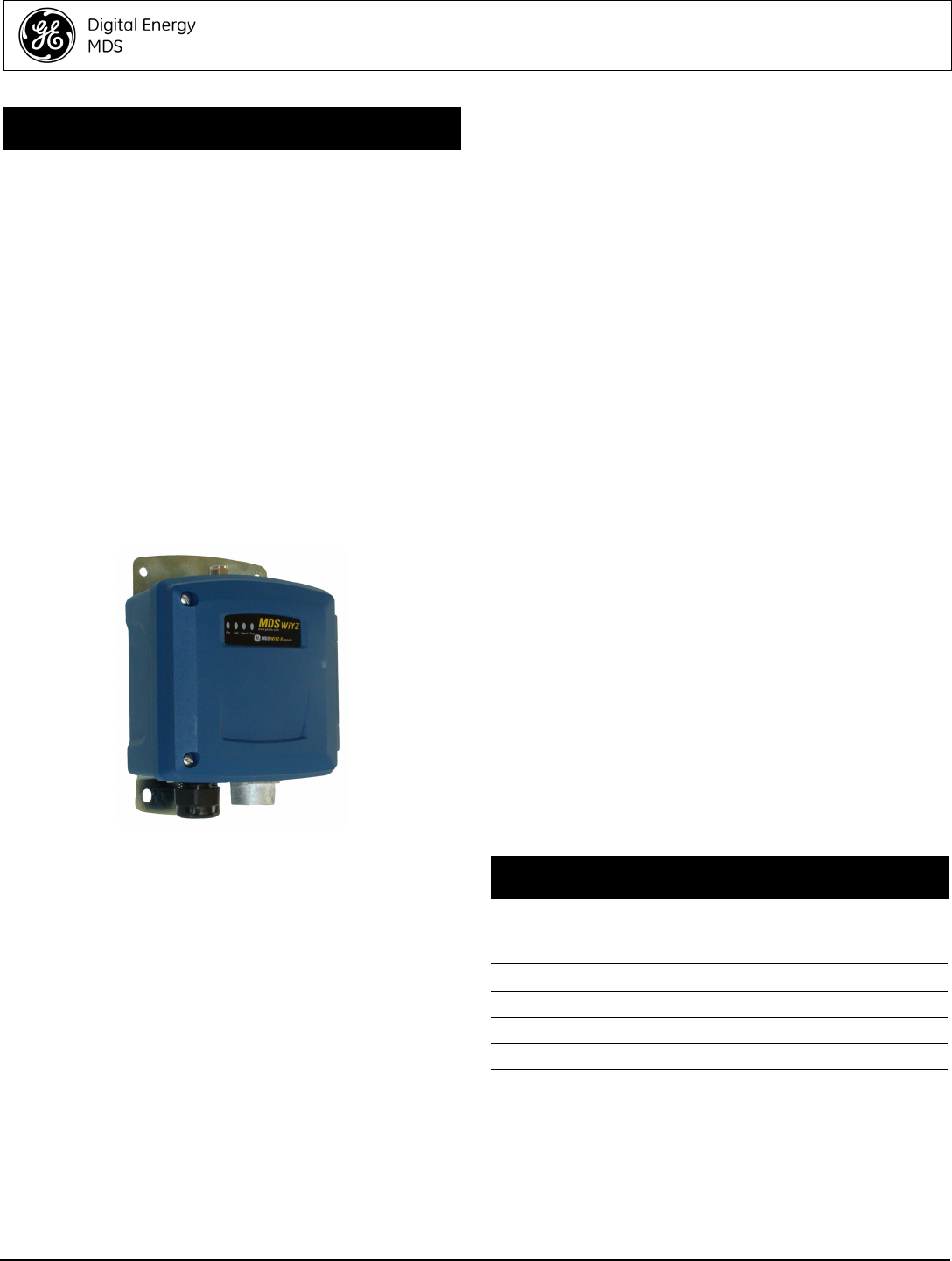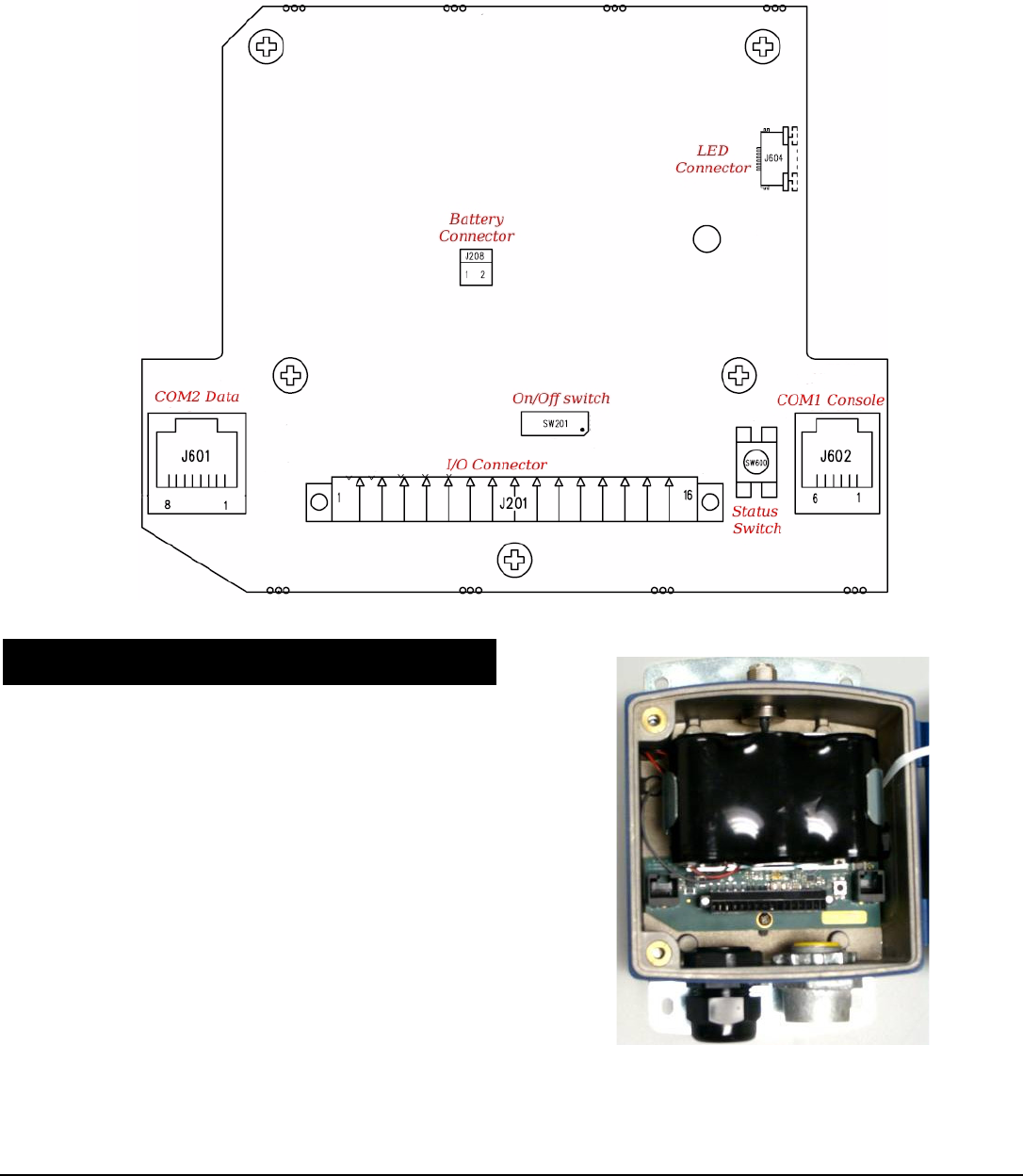GE MDS DS-MESH2400 WiYZ Mesh Radio User Manual 05 4953A01 WiYZ Remote Quickstart
GE MDS LLC WiYZ Mesh Radio 05 4953A01 WiYZ Remote Quickstart
GE MDS >
Contents
- 1. Installation Guide
- 2. User Manual
- 3. User's Manual
User Manual

1.0 INTRODUCTION
05-4953A01, Rev. 01 GE MDS WiYZ Remote Quick Start Guide 1
MDS WiYZ Remote
Publication No. 05-4953A01, Rev. 01
The GE MDS WiYZ platform allows the connection of process sen-
sors to a wireless network. Wirelessly networked sensors allow
monitoring and control of equipment and processes without the
infrastructure requirements of a hard-wired system. The WiYZ plat-
form’s IP65 Outdoor Rating allows installation of the gateway and
remotes outdoors, if required.
In addition to these instructions, the MDS WiYZ System Reference
Manual (05-4954A01) provides helpful guidance on WiYZ systems
and menus. Also refer to the MDS WiYZ Gateway Quick Start
Guide (05-4888A01). Electronic copies of all user documents and
data sheets are available free of charge at www.GEmds.com.
1.1 WiYZ Remote
The WiYZ Remote is an industrial wireless solution for monitoring
signals from directly connected sensors and other signaling
devices. It provides robust, versatile communications even in
harsh environments and at sites with limited power and communi-
cation facilities.
The unit’s self-contained design allows for quick installation and
deployment without the need for additional accessories. The WiYZ
Remote automatically determines communication routes with the
WiYZ Gateway.
Figure 1. WiYZ Remote
1.2 Typical Application
The WiYZ system allows the user to connect a network of sensors
wirelessly, and to access collected sensor data through a variety
of backhaul WAN interfaces.
The WiYZ Remotes monitor analog signals from directly con-
nected sensors and other signaling devices, such as warehouse
video cameras, tank level sensors, and OEM instruments.
1.3 Hardware Input/Output Configurations
You can order the WiYZ Remote with four different hardware I/O
configurations:
1.3.1 TRNR_PRD-72
This device supports a low voltage I/O set:
• Two digital inputs (0 -5 VDC to 24 VDC)
• Two digital outputs (2 A at 24 VDC)
• Two analog voltage inputs (0-100 mV)
• One 6 V (40 mA) sensor power supply output
1.3.2 TRNR_PRD-74
This device supports a high voltage I/O set:
• Two digital inputs (0 -5 VDC to 24 VDC)
• Two digital outputs (2 A at 24 VDC)
• Two analog voltage inputs (0-5 V)
• One 6 V (40 mA) sensor power supply output
1.3.3 TRNR_PRD-77
This device supports a current input I/O set:
• Two digital inputs (0 -5 VDC to 24 VDC)
• Two digital outputs (2 A at 24 VDC)
• Two analog current inputs (0-22 mA)
• One 24 V (40 mA) sensor power supply output
1.3.4 TRNR_PRD-78
This device supports a current output I/O set:
• Two digital inputs (0 -5 VDC to 24 VDC)
• Two digital outputs (2 A at 24 VDC)
• Two analog current outputs (4-20 mA)
• One 24 V (40 mA) sensor power supply output
2.0 HARDWARE INSTALLATION
Refer to Figure 2 on Page 3 for component locations.
2.1 COM1 (J602) RS232 Diagnostic Pinouts
RJ11 Pin Signal Direction
4 Transmit Data (TXD) Output
5 Receive Data (RXD) Input
6 Ground (GND) Input
PRELIMINARY

2 GE MDS WiYZ Remote Quick Start Guide 05-4953A01, Rev. 01
2.2 COM2 (J601) RS232/RS485 Payload
Pinouts
2.3 BATT (J208) Pinouts
2.4 Terminal Strip (J201) Pinouts
Footnotes:
1. All I/O has ESD protection.
2. Digital I/O is optically isolated from the sources with >1500 V isola-
tion.
Digital Input – Accepts voltage input from either 5 VDC to 24 VDC,
the digital inputs are interruptible, and these inputs can wake up the
Remote.
Digital Output – Can sink current 2 A @ 24 VDC, but cannot source
any voltage.
2.4.1 Digital Input Pinouts
2.4.2 Digital Output Pinouts
2.4.3 Analog Input Pinouts
2.4.4 Analog Output Pinouts
2.4.5 Current Input Pinouts
2.4.6 Current Output Pinouts
2.5 Additional Remote PCB Component
Information
Refer to Figure 2 on Page 3 for component locations.
• On/Off switch (SW201) – Use this switch to enable/disable
power to the unit. Units with a battery ship from the factory
with this switch in the OFF position.
• Antenna mount (N-Connector) is certified for use with
omni-directional antennas (up to 5 dBi gain) and Yagi anten-
nas (up to 10 dBi gain).
• Fuse (FH501) is a 2 A fuse.
• LED Ribbon Cable Connector (J604) is under the battery
bracket.
• Status Switch (SW600) – Use this switch to wake the Remote,
Activate the LEDs, and send a diagnostic message to the
WiYZ Gateway.
RJ45 Pin Signal Direction
2 Receive Data (RXD) Output
3 Transmit Data (TXD) Input
5 Ground (GND) Input
7 Request to Send (RTS) Input
8 Clear to Send (CTS) Output
Pin Signal Direction
1 Vbatt+ Output
2 Vbatt- Input
Pin Signal Direction
1Digital Input 1 (D_IN1)1,2 Input
2Digital Input 2 (D_IN2)1,2 Input
3 Digital Input Common Input
4 ISO Ground (Isolated GND) Input
5Digital Output 1 (D_OUT1)1,2 Output
6Digital Output 2 (D_OUT2)1,2 Output
7 Digital Output Common
(D_OUT_COMMON)1,2
Output
8 Ground (GND) Input
9 Volt Input 1/Current Input 1+/Current
Output 1+1
Refer to Section 2.4.1 through Section
2.4.6.
Input/Output
10 Volt Input 2/Current Input 1-/Current
Output 1-1
Refer to Section 2.4.1 through Section
2.4.6.
Input/Output
11 Ground (GND) Input
12 Volt Output 1/Current Input 2+/Current
Output 2+1
Refer to Section 2.4.1 through Section
2.4.6.
Input/Output
13 Volt Output 2/Current Input 2-/Current
Output 2-1
Refer to Section 2.4.1 through Section
2.4.6.
Input/Output
14 Power In Input
15 Ground (GND) Input
16 Sensor Power Output
Pin Signal Direction
1 Digital Input 1 Input
2 Digital Input 2 Input
3 Isolated Ground Input
Pin Signal Direction
5 Digital Output 1 Output
6 Digital Output 2 Output
7 Digital Output Common Output
Pin Signal Direction
9 Voltage In 1 Input
10 Voltage In 2 Input
Pin Signal Direction
12 Voltage Out 1 Output
13 Voltage Out 2 Output
Pin Signal Direction
9 Current In 1+ Input
10 Current In 1- Input
Pin Signal Direction
9 Current Out 1+ Output
10 Current Out 1- Output

05-4953A01, Rev. 01 GE MDS WiYZ Remote Quick Start Guide 3
2.6 WiYZ Remote Installation
Refer to Figure 3 during these steps, as required:
1. Attach the antenna. The antenna N-connector is certified for
use with omni-directional antennas (up to 5 dBi gain) and Yagi
antennas (up to 10 dBi gain). An appropriate Yagi antenna is
the Maxrad MYP24010PT (MDS P/N: 97-4278A01).
2. Mount the WiYZ Remote units. Can be mounted using a wall
mount plate, a pole mount, or strapped to a mast. Descriptions
of available accessories TBS.
3. Connect the analog cable from the sensor to be moni-
tored to the I/O connector. For more information, refer to 2.4
Terminal Strip (J201) Pinouts on Page 2.
4. For units with a battery, put Switch SW201 in the ON posi-
tion. Units with a battery ship from the factory with SW201 in
the OFF position.
5. Connect optional AC power to the Remote units. The
WiYZ Remote requires 7 to 30 Vdc. Additional details TBS.
Figure 2. WiYZ Remote PCB
3.0 SOFTWARE CONFIGURATION
1. Change the security settings of the WiYZ Remote: Need some
specific console commands in this section.
a. Connect a serial cable.
b. Change the network join key to match the value entered
at the WiYZ Gateway.
c. Enter EUI-64 of WiYZ Gateway System Manager.
d. Enter IPv6 of the WiYZ Gateway.
e. Enter SubNet ID of the WiYZ Gateway System Manager.
f. Enter Linear Calibration for all attached sensors, if
required. Refer to the MDS WiYZ System Reference
Manual (05-4954A01) for more information.
2. Check for normal operation, using the front panel LEDs. You
might need to press the Reset button to activate the LEDs.
Refer to In-Service Operation on Page 4.
3. Close the lid and secure the 1/4-turn captive screws.
Figure 3. WiYZ Remote Cabling

4.0 IN-SERVICE OPERATION
GE MDS, LLC
175 Science Parkway
Rochester, NY 14620
MDS WiYZ Remote Quick Start Guide General Business: +1 585 242-9600
05-4953A01, Rev. 01 FAX: +1 585 242-9620
October 2009 Web: www.GEmds.com
In-service operation of the WiYZ Remote is completely automatic.
The only operator actions required are to apply power and check
the front panel LEDs for proper indications as described below.
Figure 4. LED Status Indicators
• Off: No power to unit
• On/Green: Powered and active
• Slow Blink/Green: Sleep state
• Slow Blink/Red: Battery Low
• Fast Blink/Green: Battery charging (if
rechargeable battery installed)
• Fast Blink/Red: Alarmed
• OFF: Not connected to any network
• SOLID: Connected to a network
• Blink: In the process of connecting
• Off: Not joined to any network
• On: Signal Strength and channel good
• Slow Blink: Low RSSI
• Fast Blink: Channel overuse (packet loss)
• OFF: no input or output configured
• ON: at least one input or output configured
• BLINK: activity (blink for 10 seconds following
last activity
.
5.0 TROUBLESHOOTING
If trouble occurs, verify that the unit meets the basic requirements
listed below. These items should be checked prior to starting any
detailed troubleshooting, or calling for factory assistance. All instal-
lations must have:
• Adequate and stable primary power
• Secure cable connections
• Proper setup of the associated WiYZ Gateway (menu set-
tings, correct cable wiring, proper data format, timing, etc.).
5.1 LEDs
The radio’s LED indicator panel provides useful information when
troubleshooting WiYZ remote problems. Refer to Figure 4 for LED
data.
5.2 Technical Assistance
Factory technical assistance is available by contacting GE MDS
during business hours (8:30 AM to 6:00 PM Eastern Time). Please
use one of the following means to contact the factory:
Telephone: (585) 241-5510
E-mail: GEmds.TechSupport@GE.com
Web: www.GEmds.com
FAX: (585) 242-8369
FCC Part 15 Notice
This Equipment has been tested and found to comply with the limits for a Class
A digital device, pursuant to Part 15 of the FCC Rules. These limits are designed
to provide reasonable protection against harmful interference when the equip-
ment is operated in a commercial environment. This equipment generates,
uses, and can radiate radio frequency energy and, if not installed and used in
accordance with the instruction manual, may cause harmful interference to radio
communications. Operation of this equipment in a residential area is likely to
cause harmful interference in which case users will be required to correct the
interference at their own expense.
This device complies with Part 15 of the FCC Rules. Operation is subject to the
following two conditions: (1) this device may not cause harmful interference, and
(2) this device must accept any interference received; including interference that
may cause undesired operation.
RF Exposure Notice
The equipment described in this guide emits radio frequency energy. Although
the power level is low, the concentrated energy from a directional antenna may
pose a health hazard. To comply with rf exposure requirements the antenna
must be installed to ensure a minimum separation distance of 20cm from persons
and may not be collocated or operated with other transmitting devices.
This guide is intended for use by a professional installer.
Only approved antennas may be used on the unit's RF output connectors,
as listed below. The use of non-approved antennas may result in a viola-
tion of FCC rules, and subject the user to FCC enforcement action.
Warning: Changes or modifications not expressly approved by the manufacturer
could void the user’s authority to operate the equipment.
LED Name Function
Power
Link
Signal
Data
Connector Approved Antennas
N-Connector Yagi: 97-4278A01
Omni: 97-4278A48
Panel: 97-4278A16
To be Supplied To be Supplied